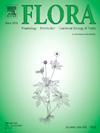草属植物在海拔梯度上的功能性状变异及适应策略
IF 1.8
4区 生物学
Q3 ECOLOGY
引用次数: 0
摘要
了解植物功能性状在环境梯度上的变异是评估植被-环境相互作用的必要条件。苔草属是温带生态系统的主要组成部分,在不同海拔梯度上表现出不同的生态适应性。研究了西喜马拉雅地区苔属植物在海拔梯度上的组成、功能性状变异及适应策略。我们假设海拔梯度影响物种组成和功能特征,从而形成适应策略。在海拔500 ~ 1000 m、1100 ~ 1500 m和1600 ~ 2000 m 3个海拔高度范围内进行了实地调查,记录了苔属植物的种类分布,并测量了苔属植物的主要功能性状。对企业社会责任战略进行评估,以确定生态适应趋势。结果显示,中海拔地区苔属植物丰富度最高的有24种。功能性状变异表现出明显的生态分化,低海拔物种表现出竞争性状,而高海拔物种表现出较强的耐受性。结果表明,植株干重和根茎数是性状分化的主要驱动因素。CSR分析揭示了低海拔地区的竞争策略向高海拔地区的抗逆性策略的转变,反映了资源可用性和非生物约束。这些发现强调了苔属植物的生态适应性和海拔在植物功能性状形成中的作用。该研究提供了对植物适应机制的关键理解,有助于在不断变化的环境条件下保护西喜马拉雅地区的植物。本文章由计算机程序翻译,如有差异,请以英文原文为准。
Functional trait variability and adaptive strategies of Genus Carex along the elevation gradients
Understanding the variability of plant functional traits along environmental gradients is essential for assessing vegetation-environment interactions. The genus Carex, a dominant component of temperate ecosystems, exhibits diverse ecological adaptations across elevation gradients. This study investigates the composition, functional trait variations, and adaptive strategies of Carex species along an elevational gradient in the Western Himalayas. We hypothesized that elevational gradients influence species composition and functional traits, thereby shaping adaptive strategies. We conducted field surveys across three elevation ranges (500–1000 m, 1100–1500 m, and 1600–2000 m), recording Carex species distribution and measuring key functional traits. CSR strategies were evaluated to determine ecological adaptation trends. Results revealed 24 Carex species with the highest richness at mid-elevations. Functional trait variations demonstrated significant ecological differentiation, with species at lower elevations exhibiting competitive traits, whereas stress tolerance increased at higher altitudes. Results indicated that plant dry weight and number of rhizomes were major drivers of trait differentiation. CSR analysis revealed a shift from competitive strategies at lower elevations to stress-tolerant strategies at higher elevations, reflecting resource availability and abiotic constraints. These findings highlight the ecological adaptability of Carex species and the role of elevation in shaping plant functional traits. The study provides critical understanding of plant adaptation mechanisms, aiding conservation efforts in the Western Himalayas under changing environmental conditions.
求助全文
通过发布文献求助,成功后即可免费获取论文全文。
去求助
来源期刊

Flora
生物-植物科学
CiteScore
3.30
自引率
10.50%
发文量
130
审稿时长
54 days
期刊介绍:
FLORA publishes original contributions and review articles on plant structure (morphology and anatomy), plant distribution (incl. phylogeography) and plant functional ecology (ecophysiology, population ecology and population genetics, organismic interactions, community ecology, ecosystem ecology). Manuscripts (both original and review articles) on a single topic can be compiled in Special Issues, for which suggestions are welcome.
FLORA, the scientific botanical journal with the longest uninterrupted publication sequence (since 1818), considers manuscripts in the above areas which appeal a broad scientific and international readership. Manuscripts focused on floristics and vegetation science will only be considered if they exceed the pure descriptive approach and have relevance for interpreting plant morphology, distribution or ecology. Manuscripts whose content is restricted to purely systematic and nomenclature matters, to geobotanical aspects of only local interest, to pure applications in agri-, horti- or silviculture and pharmacology, and experimental studies dealing exclusively with investigations at the cellular and subcellular level will not be accepted. Manuscripts dealing with comparative and evolutionary aspects of morphology, anatomy and development are welcome.
 求助内容:
求助内容: 应助结果提醒方式:
应助结果提醒方式:


